Marco Travaglini (Translation Rosella Simonari)
Atelier Alberto Spadolini
7 January, 2018
We recently ran an article on “Operetta in the Third Reich,” reporting on the new book of the same title by Matthias Kauffmann. There was a surprise feature in that book: ‘nude’ dancer Alberto Spadolini, heroically posing for a Lustige Witwe production in Berlin 1940. That production starred Johannes Heesters as Danilo and was directed by Georg Jacobi, husband of Marika Rökk (with whom he made Gasparone among other films). Of course we wondered who this Mr. Spadolini could possibly be, and why on earth he popped up in a Lehár operetta in the midst of World War 2 in ther German capital? As coincidence would have it, the nephew of Alberto Spadolini contacted us. Marco Travaglini runs the Atelier Alberto Spadolini in Italy, he has published various books on his uncle’s career, and helped create articles. They shed an interesting light on this once celebrated dancer, and make it all the more fascinating that Spadolini (as a “jazz dancer” and ex-partner of Josephine Baker) was chosen to be in this prestigious operetta production: as an erotic attraction for female audiences. (Remember, most men were at war by then.) Mr. Travaglini has allowed us to post an English language article on his uncle on this website, which has some staggering facts about Spadolini working as a spy and being in the Resistance, at the same time that he was performing in Lustige Witwe.
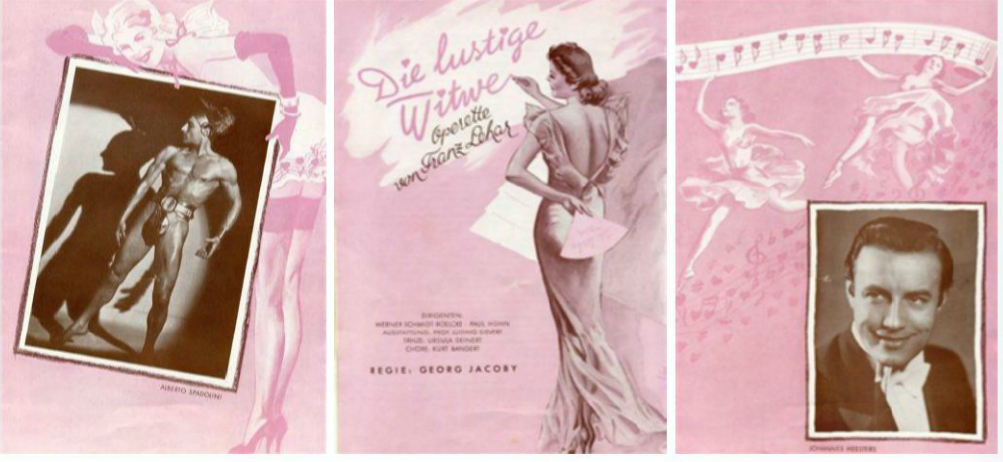
The program for the 1940 production of “Die lustige Witwe” with Johannes Heesters (r.) and Alberto Spadolini (l.). (Photo: Collection Marco Travaglini/Atelier Alberto Spadolini)
“There was a group of friends at the Casino de Paris, including the naked dancer Spadolini – although, on this particular occasion, he was clothed,‟ wrote Josephine Baker (1906 – 1975) in her Memoirs, compiled in 1935 by the writer André Rivollet.
It is no coincidence that Rivollet should have singled out Spadolini for mention at the beginning of these Memoirs. The two dancers were inseparable, on stage and off, in the show La Joie de Paris at the Casino de Paris, and in the tours of Europe.
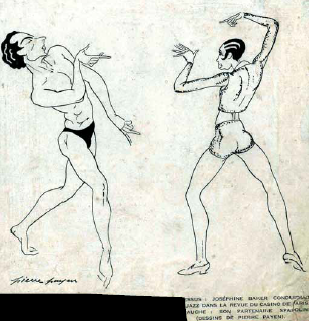
Newspaper caricature of Alberto Spadolini dancing with Josephine Baker. (Photo: Collection Marco Travaglini/Atelier Alberto Spadolini)
A series of articles dating from this time show images of the two artists clinging to one another in a dance at the Casino, and again at Paris airport.
“Paris still remembers the night it discovered Spadolini,” runs one of them. “It was at one of Josephine Baker’s revues. To the music of Cimarosa’s Secret Marriage, against a background that looked vaguely Chinese, Spadolini emerged as though from some eighteenth-century painting, together with Josephine, dressed as a Creole marquise. It was a marvellous sight, greeted with enthusiasm by le tout Paris.”
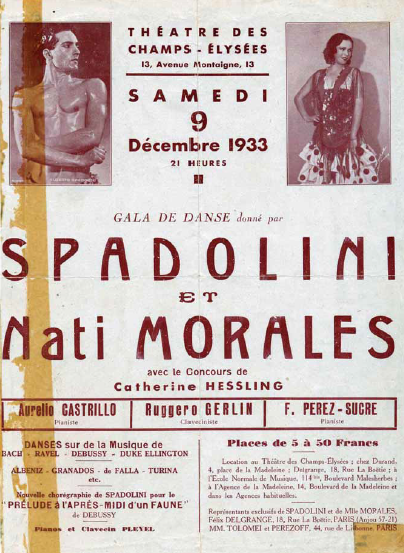
Poster for a 1933 performance of Alberto Spadolini in Paris at the Théatre des Champs-Èlysées, with Nati Morales. (Photo: Collection Marco Travaglini/Atelier Alberto Spadolini)
Between 1932 and 1934 the two artists were extremely close, and indeed, according to some, towards the end of this period they were secret lovers; this theory is endorsed by several contemporary items in the press.
Alberto Spadolini (1907-1972), begins his activity as set designer assistant and painter at the Teatro degli Indipendenti in Rome, a meeting venue for the Italian artistic vanguards, where artists and intellectuals like Giorgio De Chirico and Filippo Tommaso Marinetti often met. At the end of the 1920s the theatre closed for pressing financial problems and Benito Mussolini’s pressure, as he badly tolerated that group of young people who had nicknamed him “the violinist.”
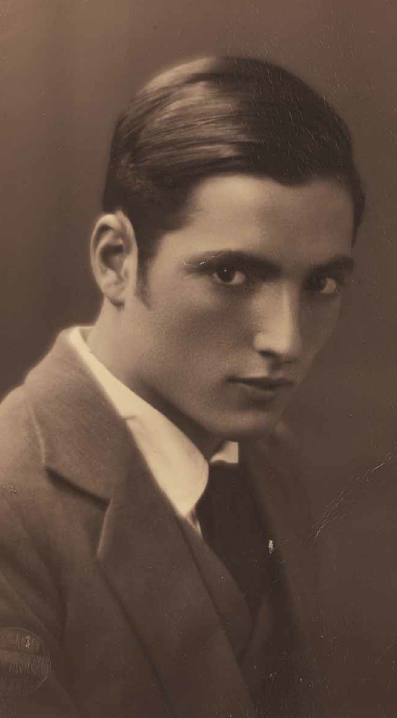
The young Alberto Spadolini, studio of the Fratelli Mammoli in Ancona, 1920s. (Photo: Collection Marco Travaglini/Atelier Alberto Spadolini)
In 1931 we find Spadolini in the French Riviera: paint-smeared and sweat-soaked, he was painting the set for a dance hall when, all of a sudden, he began to dance as if he had been possessed by a divine power. He abandons paint brush and palette and becomes “Premier Danseur de l’Opéra de Monte Carlo”. He is acclaimed as the new Nijinsky, performs with Serge Lifar, makes Picasso jealous of him, runs away with Jean Renoir’s wife, but does not disdain to appear in charity shows to honor the Garibaldini from Argonne and the War Mutilated and Crosses.
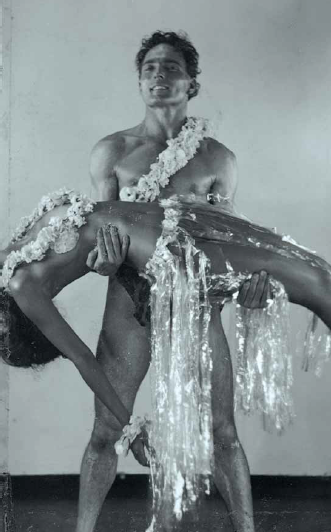
Alberto Spadolini performing “Hawaii” with Josephine Baker at the Casinò de Paris, 1933. (Photo: Collection Marco Travaglini/Atelier Alberto Spadolini)
Josephine herself tells us of her secret war: enrolled by the French secret services as the Second World War broke out, she is given the task of bringing information of vital importance transcribed on the music sheet with invisible ink: “…she is thought to have transferred to Portugal all the information gained on the German army in the east of France. The information included location of air bases, harbours and landing crafts. The information was related to a possible attack against Gibraltar…and to the expected landing in November 1940 of Abwehr II’s agents on the Welsh coast.”
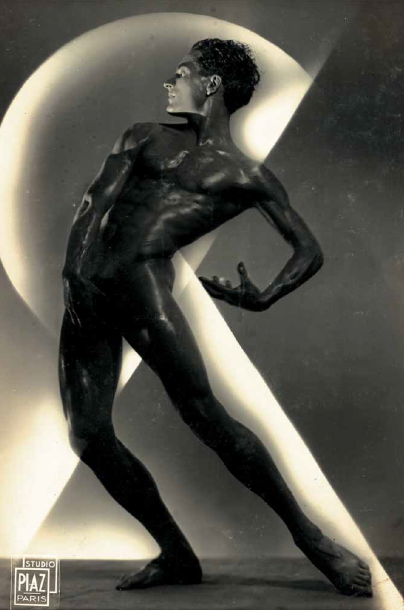
Alberto Spadolini in “futuristic style,” portayed by Studio Piaz in Paris. (Photo: Collection Marco Travaglini/Atelier Alberto Spadolini)
Spadolini is involved in the anti-Nazi resistance, too. In an article published in 2007, Jean-François Crance remembers “…his war [was] generous, dangerous, reckless!”
Spadò performs in Germany from September 1940 to February 1941. In Berlin he embodies the “God of War” in the operetta Die lustige Witwe, during Franz Lehár’s 70th birthday, in front of Adolf Hitler and the most important Nazi hierarchs. The show also features the performance of the singer Johannes Heesters, who is the victim of a terrible joke: when his house is bombed by the RAF, his friends, without giving him much explanation, send him to sleep in the legendary Salon Kitty, “refined brothel” placed under the Gestapo’s direct surveillance.
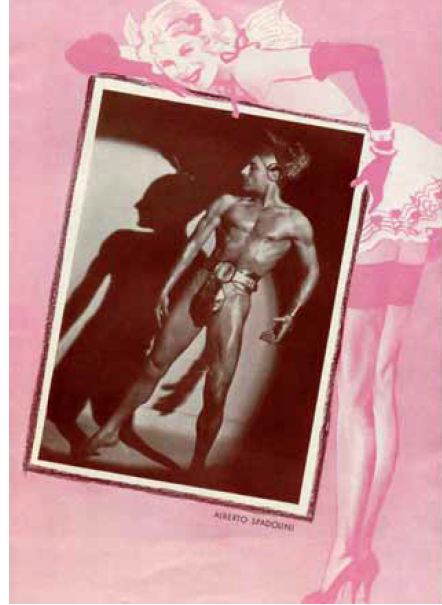
A pretty lady in pink holding a photo of Alberto Spadolini in the “Lustige Witwe” program book, 1940. (Photo: Collection Marco Travaglini/Atelier Alberto Spadolini)
It is surely not because he is distracted that Spadolini avoids the accusation of collaboration because he performed in Nazi Germany. Unlike Serge Lifar, who, after the liberation, is expelled from the direction of the Paris Opéra Ballet, the Italian artist is treated with all the honours and, at the end of the war, he resumes his performances at the Palais de Chaillot, his expositions at the Circle de l’Union Française, and to be interviewed by newspapers born out of the resistance like Libération.
The newspapers of the period write: “Spadolini is commonly called the Apollo of dancing. He has conquered Paris, New York and the big cities in South America. His lodgings are in Montmartre. In order for him to train, the French authorities have let him use the Palais de Chaillot along the Seine, near the Eiffel Tower. After Serge Lifar’s fall into disfavour, due to his performance for Hitler’s troops during the German occupation of France, Spadolini is now considered the number one …”
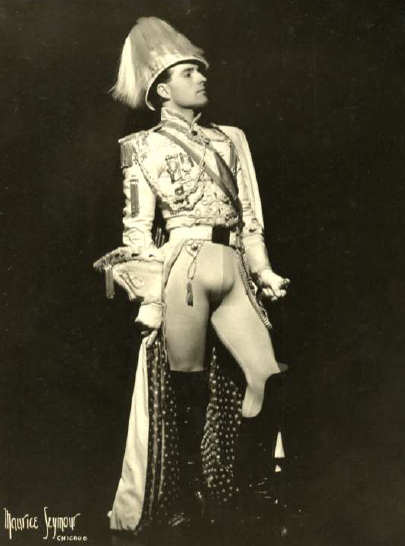
Maurice Seymour’s portrait of “Spadolini,” Chicago 1935. (Photo: Collection Marco Travaglini/Atelier Alberto Spadolini)
In an interview, the Russian aristocrat Alex Wolfson reveals that in Stockholm, during the Second World War, Spadolini meets a mysterious character: Yves Gyldén. However, it is only with the publication of the volume Ciphered Code (2005) that we understand the role played by Gyldén in these events: born of a Swedish father and a French mother, he spent many years in France where he studied secret codes with alacrity.
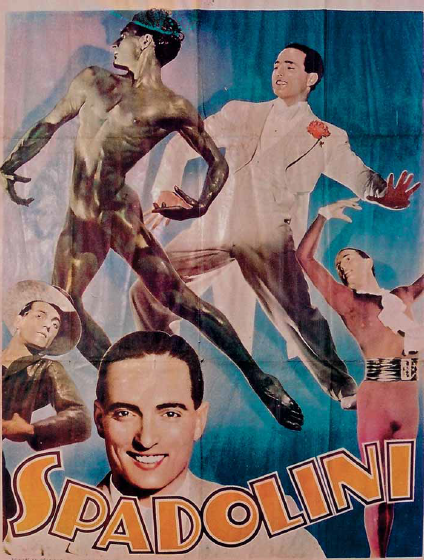
Spadolini poster: “Imprimé en Belgique – Papeteries De Genval 1930s. (Photo: Collection Marco Travaglini/Atelier Alberto Spadolini)
Back in Sweden, Mr. Gyldén continued his studies to decipher codes until the autumn of 1939, when he was called to direct the group of code experts who have the task to decipher the French diplomatic code.
In France some photographs have recently been found, portraying Alberto Spadolini in 1972, the year he died.

Alberto Spadolini in the autumn of 1972, from the C. Petix collection. (Photo: Collection Marco Travaglini/Atelier Alberto Spadolini)
He poses as if he were playing the role of a … spy. In the first photograph his long white dress and sunglasses recall Lawrence of Arabia. In the second, he is sporting a formal suit and he has an heroic and ironic glance. In the third one he is about to open a door, his eyes once again hidden by dark sunglasses…with Spadolini everything seems to be a conscious choice.
Recently the Italian journalist Cristiano Lovatelli Ravarino let us know about an interesting exchange he had with the head of Intelligence Hugh Montgomery:
Years ago Hugh Montgomery – maybe the brightest head of Intelligence I have ever met – asked me if the agent Spadolini was a relative of the Italian Prime Minister Giovanni Spadolini … I answered that I had no information on the matter. “Is he still in the field?” “Honestly, I have never heard about such an agent,” I observed. “Brilliant!” “What do you mean, brilliant?” “I mean brilliant Spadolini: the best agent is the one whose existence you can’t even guess.”
Spadolini travels restlessly across Europe, America, Asia, Africa…Nearly every year the artist, who speaks about ten languages, including Arabic, goes to Oran in Algeria, where he has got several friends.
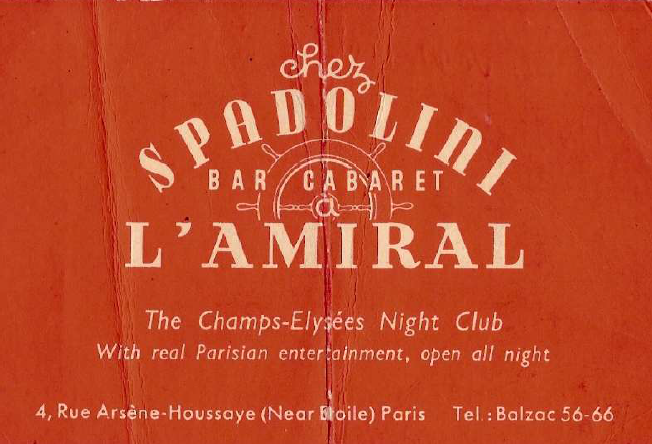
Advertisement of the cabaret, Chez Spadolini ar L’Amiral in Paris, 1948. (Photo: Collection Marco Travaglini/Atelier Alberto Spadolini)
In Sweden he is so warmly welcomed that he begins to be considered a Swedish painter; in 1948 in Stockholm at the vernissage for his exhibition at the Oscarsteatern, the stars of Swedish theatre take part; furthermore, he displays his work in Malmö and at the Bohmans Konstgalleri in Stockholm until 1972.
The artist is to be found in Vietnam in March 1954, precisely during the Dien-Bien-Fu battle, and he witnesses the epic struggle between the French army and General Giap’s communists. Some ads place Spadolini in Saigon on April 10th 1954 for a dance performance and, it is in Saigon that he displays his paintings on May 12th 1954. Professor Philip Kearney refers to an encounter at the United States Embassy in Saigon between the Italian artist and his parents Daniel and Helen Kearney, who were responsible for the organisation of a cooperative and development project in Vietnam. On that occasion Spadolini, always a generous man, gave to his new friends a painting portraying dancers as a gift.
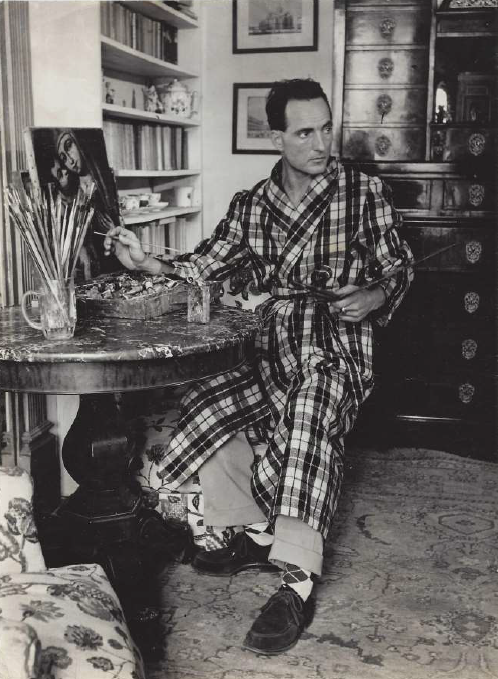
Joe Pazen, “Spadolini danseur et peintre,” Paris 1946; Pierre Barlatier De Mas Collection. (Photo: Collection Marco Travaglini/Atelier Alberto Spadolini)
Spadolini was familiar with various people in the diplomatic world: at the 1955 vernissage, organised in occasion of the exhibition sponsored by his friend, prince Felix Yussupov at the Galerie Bradtké in Luxembourg, a lot of important people took part: Pierre-Alfred Saffroy, French plenipotentiary ambassador, and the representatives from the delegation of the United States, Great Britain and Italy.
We like to conclude with the image of Spadolini, ambassador of Italian art in the world, with his luggage and a lit cigarette dangling from his mouth, in the act of leaving for a new exploit.
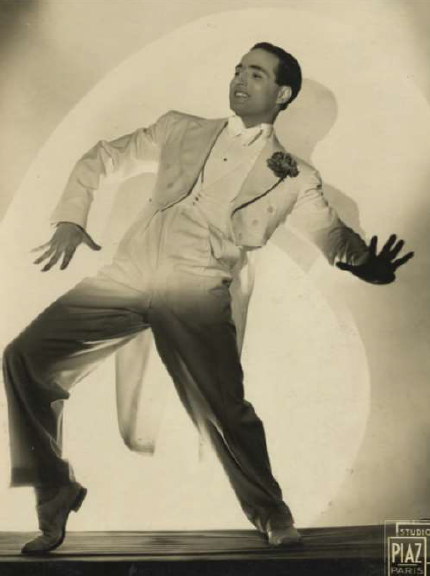
Alberto Spadolini as a “jazz” dancer, Studio Piaz in Paris, 1930s. (Photo: Collection Marco Travaglini/Atelier Alberto Spadolini)
How was all of this information found?
Some years ago a teacher found a box in a loft which contained some old papers, or what looked like old papers. Inside it, he discovered hundreds of articles coming from all over the world: documents, leaflets, posters, paintings, and an extraordinary collection of photos about dance in the 1930s.
It was the archive of Alberto Spadolini, friendly nicknamed “Spado” in France, now considered one of the most eclectic artists of all time. Mr Marco Travaglini, an Italian teacher who made this discovery, has painstakingly rebuilt Spadolini’s story, like a puzzle. Mr. Spadolini was working as an apprentice stage designerat the Teatro degli Indipendenti in Rome when he migrated to Paris at the end of the 1920s. Here, he worked as a decoratorat Paul Colin’s atelier. A few months later, he became a dancerwhit Serge Lifar, Mistinguett and Joséphine Baker (with whom he seems to have had a stormy love affair); he was a choreographer, appreciated by Marlene Dietrich, Paul Valery, Maurice Ravel (after directing him in “Bolero”, Ravel thought Spadolini’s choreography to be in perfect harmony with his music); then, he became an actorwith Charles Boyer, Jean Gabin, Jean Marais, and the protagonist of a documentary on dance (commentary and costumes by Jean Cocteau); directorof a series of short films about dance with the jazz musician Django Reinhart; dialogue adapterfor sir Alexander Korda (the film “The tales of Hoffmann” , in which he worked as a collaborator, won the Best Production Award at Cannes Festival in 1951); in the 1940s he became a singerand released the record “E tu pallida luna”; moreover, he worked as a sculptor, able to give a soul to his works; as well as a restorerof the castles on the Loire, of houses and discotheques; he was an extraordinary painterall his life, appreciated by Anton Giulio Bragaglia, Max Jacob, Prince Felix Yussupoff, Jean Cocteau …
For more information on the Atelier Alberto Spadolini, click here. And to read the printed version of the Spadolini biography (in English), click here.

hot!!!!!!!!!!!!!!!!!!!!!!!!!!!!!!!!!!!!!!!!!!!!!!!!